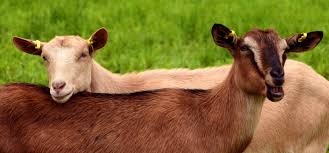Moushumi Bharali, Liyena Medhi, Suprativ Sarma, Mridul Hassan, Kandarpa Boruah*
Lakhimpur College of Veterinary Science,
Assam Agricultural University, North Lakhimpur, Assam
*Corresponding author
Email: kandarpaboruah46@aau.ac.in
INTRODUCTION
The goat was the earliest ruminant domesticated by man around 9000-7000 BC. It is popularly known as the poor man’s cow due to its important role in improving the socio-economic condition of landless, small and marginal farmers. It also plays a significant role in the economic upliftment of the nation as well as in employment generation for the educated youth. In the northeastern region of India, goat is mainly reared for meat purpose, due the high demand for its meat. Goat is the species of choice among the farmers for rearing due to its hardiness, versatility, feeding habits and prolificacy. The commonly reared breeds in the NE regions are Assam Hill goat, Black Bengal, Beetal and Sirohi crosses with Assam Hill Goat.
Assam Hill Goat: It is a native breed of Assam with high adaptability to the local climatic conditions, disease resistance and high prolificacy, which is mostly reared for meat purpose.
- Age at sexual maturity of female: 7-8 months
- Age at first kidding: 13-14 months
- Kidding interval: 247.73 ± 4.54 days
- Weighs about 14 kg at 12 months of age
Black Bengal: It is found in West Bengal, Bangladesh and in some parts of Assam; it is a meat purpose breed and has high prolificacy. It weighs about 15 kg at 12 months of age.
Beetal: It is a native breed of Punjab and Haryana reared for both milk and meat purposes. Weighs about 21 kg at 12 months of age. Its average lactation yield is 195 kg in about 224 days.
Sirohi: Native breed of Rajasthan and Gujarat (Palampur) reared primarily for meat purpose.
CLIMATIC CONDITIONS
The northeastern region typically falls under the “tropical monsoon rainfall” type with high level of humidity and heavy rainfall, confined within four summer months from June to September. The summer temperature in the plain varies between 30 and 33 °C (Dikshit et al., 2014). The average rainfall is around 2000 mm with local variation in the Brahmaputra valley. The climate is moderate throughout the year with warm summer and mild winters.
HOUSING
In the NE region of India, farmers rearing goats for commercial as well as traditional purposes generally follow both intensive and semi-intensive system of rearing. Goat prefers clean, dry and well-ventilated housing. So, it is necessary to design a goat’s shade with adequate space, proper ventilation, good drainage and plenty of light. The slatted type of housing is preferred in the NE region due to high humidity and heavy rainfall. As goats need protection against possible water logging, in this type of housing, the floor is elevated approximately 4.5-5 feet above ground to facilitate cleaning. Another floor underneath the slatted one may be provided where the urine and dung will fall which should be regularly cleaned.
Bamboo slats or wooden slats 3″ thick and 1″ wide may be used as flooring material which are laid one after another with about 1 cm gap in between. In this system, a space of 2′6″ x 4′6″ is required for each goat.
The walls may be constructed with bamboo or timber with provision for adequate ventilation. Roof may be constructed with thatch or materials which can maintain more or less equitable temperature in all seasons. An open fenced area should be provided for exercises, feeding rack and water trough should be arranged in the house. Advantage of slatted housing is that the goats will not come in direct contact with their urine and faeces, thereby preventing occurrence of various parasitic and respiratory diseases. In commercialized goat farms, the following sheds can be constructed for different group of animals: General flock shed, Buck shed, Kidding shed, Kid shed, Segregation shed.
HEALTH CARE AND MANAGEMENT
Goat needs special attention during summer, they should be provided with shady areas along with ad libitum clean drinking water fortified with electrolytes.
Large quantity of ammonia is released in the excreta of goats which are further increased during the summer season. Breathing of this gas is harmful for goats; so, thorough cleaning of the sheds is necessary. A dirty shed also invites skin sores, mastitis, respiratory ailments, digestive problems, foot problems and more which are seen to be highest during the summer and rainy seasons. In comparison to other livestock, diseases occur less frequently in case of goats. Few important diseases with high occurrence in summer and rainy seasons are listed below:
Bacterial diseases:
- Enterotoxaemia: It is caused by Clostridium perfringens type D.
- Predisposing factors are excessive consumption of succulent grass, sudden change of diet and excess feeding of concentrate.
- The common clinical signs are distended abdomen, dyspnea, rolling of eyeball, extension of legs, stiffness of neck and diarrhoea.
- Pneumonia: It is caused by organisms belonging to the genus Pasteurella.
- Clinical signs: Fever, nasal discharge, coughing, dyspnea and off fed.
- Colibacillosis: It is caused by Escherichia coli and is commonly seen in kids.
- Symptoms include diarrhoea, dehydration, depression, soiling of the anal region.
Viral diseases:
- Contagious ecthyma (Orf): It is caused by Orf virus is a member of the Parapoxvirus genus in the Poxvirus family.
- Clinical signs: papules around the facial region, teat and around vulva.
- Foot and Mouth Disease: It is caused by Apthous virus, which produces vesicles in the mouth and interdigital space. There is excessive drooling of saliva and animal is unable to eat properly due to ulcer formation.
- PPR: It is a highly infectious viral disease of small ruminants caused by Morbili virus.
- Signs: fever, lacrimation, diarrhoea and nasal discharge.
- Goat pox: It is caused by Capripox virus and characterized by fever, mucopurulent discharge from nostrils and widespread skin lesions in the areas free of long hairs.
VACCINATION SCHEDULE
| Disease | Primary dose | Revaccination |
| Enterotoxaemia (ET)
|
At 3-4 months of age
|
6 monthly |
| Foot and Mouth Disease (FMD) | At 3-4 months of age | Every 6/12 months interval |
| Peste-des-Petitis Ruminants (PPR) | At 3-4 months of age | Annual |
| Goat Pox | At 3-4 months of age | Annual |
| Hemorrhage Septicemia (HS) | At 3-4 months of age | Every 6/12 months interval |
Parasitic diseases: The agroclimatic conditions of Northeast India favour occurrence of parasitic diseases such as Nematodes, Trematodes, Cestodes and ectoparasites. Foul-smelling diarrhoea, dehydration, anaemia, debility and off-fed are the commonly observed clinical symptoms. Gid is also an occasional disease in goats which is generally fatal and is characterized by head pressing and circling movement. Surgical intervention is necessary to treat the diseased animal.
PREVENTION
- Regular screening of dung and deworming of anthelmintics.
- For nematodes : Benzimidazole group of drugs (e.g., Albendazole, Fenbendazole) and Ivermectin
- For Trematodes : Oxyclozanide and Triclabendazole (for fasciolosis)
- For Cestodes : Praziquantel, Niclosamide, Closantel
CONTROL
- By controlling snails
- Chemical control of molluscicides by using Copper sulphate, Sodium pentachlorphenate, n-tritylmorphine, etc.
- Biological control of snails by using predators which feed on them, g., ducks.
- Physical destruction
- By controlling animals from picking up infection by not allowing them to graze near water holdings especially during late summer when normal grazing grounds become dried and after monsoon when population of snail is at peak.
- Grazing management by adopting rotational grazing; also cross grazing system should be practiced in plains. Adult and young animals should be grazed in separate pasture as adults act as carriers.
- Stall feeding should be strictly followed during the rainy months particularly during mid part of May to July.
- Regular deworming and vaccination are to be practiced at timely intervals. Alternate composition of anthelminthics is to be used every after 3- 4 months interval for deworming of goat.
An important ectoparasitic disease of goats is mange, which is caused by mites. It is characterized by itching, alopecia, thickening of skin and rough body coat. The affected part can be treated with antiseptics followed by application or dipping in acaricides (e.g., Amitraz, Cypermethrin, Deltamethrin), and Ivermectin. Also, water extract of tobacco leaves can be applied on the affected part.
SUMMARY
Despite the challenges faced in rearing of goats during the summer and rainy seasons of the northeastern region, it is reared by a large section of the rural population due to its multifunctional properties. Considering its prolificacy, adaptability, availability, demand of the local people for chevon due to its low cholesterol content, and absence of taboo against its slaughter and consumption, goat is a potential animal next to pig for economic meat production in most of the states of the NE region. Moreover, goat milk is easy to digest, non-allergic compared to cow milk and is believed to have antifungal and antibacterial properties. Goat farming also creates employment for the rural poor besides effectively utilizing unpaid family labour. Adaption of modern and well-established scientific principles, practices and skills will further help to obtain maximum economic benefits from goat farming.
References:
Boruah, K.; Khuman, L. S.; Khargharia, S.; Payeng, S.; Johari, M.; Bordoloi, G.; Mahanta, D.; Baruah, A.; Kalita, M.K.; Saikia, K. and Baishya, M.P. (2020). Shelter management practices of goat by the farmers of Lakhimpur and Dhemaji districts of Assam. International Journal of Chemical Studies. ; SP8(5):105-108.
Dixit, K.R. and Dikshit J.K. (2014). Weather and climate of North-East India. North-East India: Land, People and Economy. (pp.149-173 (DOI:10.1007/978-94-007-7055-36).
Goat management (https://veterinary.assam.gov.in › level_1)




